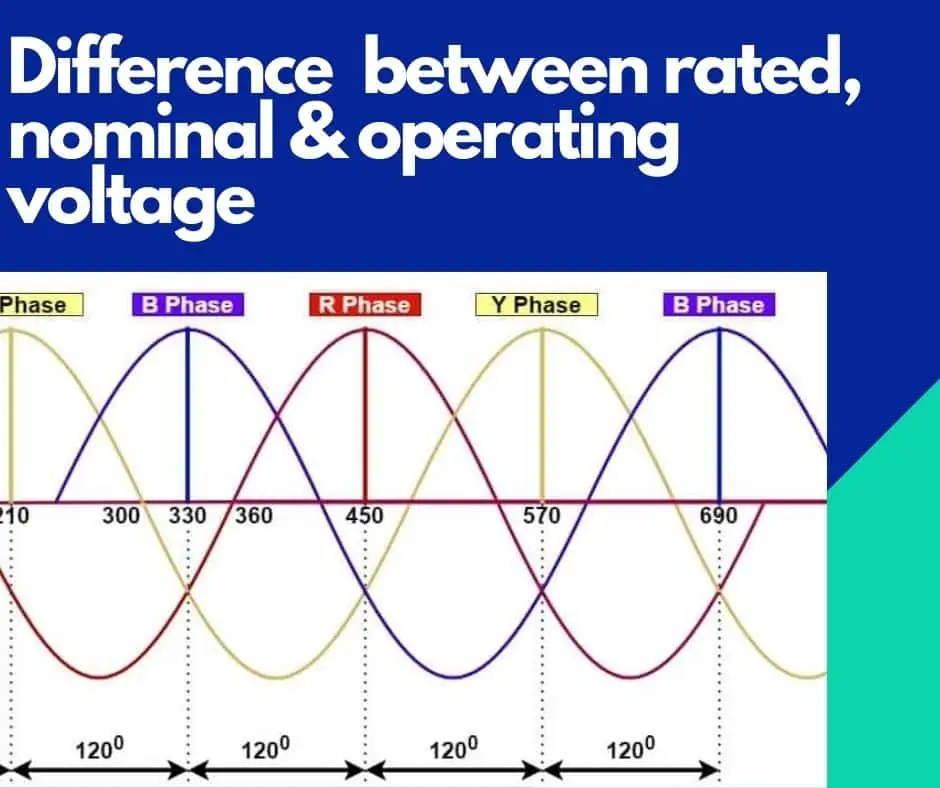In this post, we will discuss the difference between rated, nominal, and operating voltage. Operating at the designed operating voltage enhances the equipment’s life.
There are three voltage rating terms widely used for electrical equipment.
- Rated Voltage
- Nominal Voltage
- Operating Voltage

Rated Voltage
The rated voltage is the voltage for which equipment is designed to operate reliably. Thus, the rated voltage of any electrical equipment is the maximum voltage at which equipment can be operated within its thermal limit without jeopardizing its life. The equipment designer also takes voltage safety margins into consideration when designing for the operation of equipment within the range of rated voltage.
| Read More: What is Voltage? |
On the nameplate of the motor, the rated voltage is engraved as 440+/- 10 %. It means the equipment can be operated safely in the voltage range of 396 to 484 volts. The lower limit of the voltage is 396 volts, and the higher limit of the voltage is 484 volts. If the equipment is operated within this range, the equipment will work reliably. The +/10 % margin is the voltage safety margin.
Nominal Voltage
The nominal voltage is the voltage level of the electrical power system. The system voltage is 440 V, 690 V, 3.3 kV, 6.6 kV, 11kV, 33 kV, 66 kV, 132 kV, 220 kV, 400 kV, 765 kV. The voltage level of the electrical power system is known as nominal voltage or system voltage. The equipment designer first considers the nominal voltage for which the equipment is operated. The designer takes the voltage safety margin of +/- 10 % or higher while equipment designing.
Operating Voltage
The operating voltage of the equipment is the voltage at which the equipment is being operated. The equipment must be operated within the range of rated voltage for reliable operation. For example, an induction motor rated at 440 V +/- 10 % can be operated within the voltage range of 396 to 484 V for the nominal or system voltage of 440 Volts. The operating voltage is the actual voltage applied at the equipment terminal.
The actual measurement of the voltage applied to the equipment terminal can be measured with a multimeter. The voltage at which equipment is being operated is called the operating voltage. The operating voltage of the equipment should be in the range of rated voltage for safe, economical, and reliable operation.
In some of the equipment, like an induction motor, if the applied voltage is higher or lower in magnitude than its rated voltage, the performance of the equipment gets badly affected.
For example, a circuit breaker installed for a 132 KV power system has the following specifications.
Nominal Voltage – 132 KV
Rated Voltage – 132 KV +/- 10 % [118.8 – 145.2 KV ]
Operating Voltage – Can be in the range of 118.8 to 145.2 KV.
The equipment designer keeps the maximum rated voltage of the equipment above the nominal voltage or system voltage. Equipment designed at a higher voltage than its maximum rated voltage has a better factor of safety.
If the operating voltage is not within the range of rated voltage, equipment operation gets adversely affected. The utility company maintains the system voltage within +/- 10 % range.
Thanks!
Thank you .
Thank you sir i understood what is rated voltage in this description. Then what will be the no load voltage. Pls. Explain me
The term ‘no load voltage’ is commonly used to describe the voltage of a power source when no load is connected to it. In the case of a battery or cell, it refers to the voltage at its output terminal when no current is flowing. Similarly, for a generator, the no-load voltage is the output voltage at its terminal when there is no current flowing through it.
Very nice simple technical explanation.